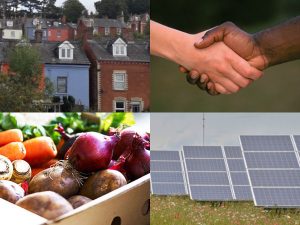Conventional banks have been given a state monopoly on the creation of money-as-debt, with compound interest attached. You couldn’t invent a system that concentrates wealth and damages nature more, if you tried.
With mutual credit, we can build a global Credit Commons that takes the control of money from banks – replacing currency with credit and commoning the means of exchange.
Peer-to-peer commons / commons-based peer production / P2P commons (all the same thing) has been an emerging global economic phenomenon for 40 years or so, receiving increasing attention in the past decade. It is now clear that a huge distributed community of creative people can build very complex things without hierarchy, which are equally available to anyone for further use.
This arose in the fields of software production (with the Linux computer operating system and the git version-control protocol for software development) and digital media; Wikipedia.
In capitalism, markets and prices are typically seen as necessary means of coordination across an economy. But in the past 25 years the global supply chains of corporations have developed IT-based means of directly coordinating supply chain operations ‘just in time’, without holding wasteful buffer stocks and without resorting to price-based market interactions.
These capabilities are now being developed in a new class of software tools for network resource planning, which enable actual concrete activities to be mapped, coordinated and evaluated against many kinds of metrics, including environmental energy metrics and tracking of sustainable sources and processes. [Bob Haugen describes a minimal bottom-up economic infrastructure]
It’s early days yet. But keep an eye on the development work of Mikorizal Software with various kinds of coops [Lynn Foster talks about ValueFlows and NRP tools], and follow the stories of distributed collaborative organisations like Sensorica (light engineering), Enspiral (community-oriented services and platforms), Guerilla Translation (what the name says) and Buurtzorg (community care). Also check out the ongoing research the P2P Foundation on thermodynamic accounting.
Cars, housing and farm equipment are now among physical things that can be designed in a git-style, P2P way, deploying globally-sourced designs in local (cooperative) manufacture. At the material end of this chain are Fablabs (fab as in fabrication): venues equipped with workspace, tools and machinery (including digital-driven material-forming machines like 3D printers). This is sometimes known as open hardware; its basic principle is ‘think global, build local’.
Freely available, git-developed global-generic designs can be ‘forked’ to produce local variants with local materials and labour. For example, farmers can pull down designs, and tinker with them to build what they need. Makerspaces is another name. It’s a bit like a wiki, for buildable designs rather than broad concepts and generic information.
The P2P commons is not the whole world, and interactions with capitalist commodity markets are inescapable. To deal with this, there’s a lot of ongoing work on forms of licensing designed to enable accumulation (of value) in the commons – that is, expansion of capability in the commons economy – and to prevent either enclosure or free-riding in fields of commons resources, by for-profit firms. Versions of licensing include Copyleft, Patentleft, Creative Commons, Peer Production and GNU.
The design and selection of licensing regimes can be quite technical (just like any design); sometimes there are controversies between these models. But this is a skill that’s becoming more widespread – just like the design of non-commodity currencies, credit systems, OpenValue supply chains and P2P protocols.

